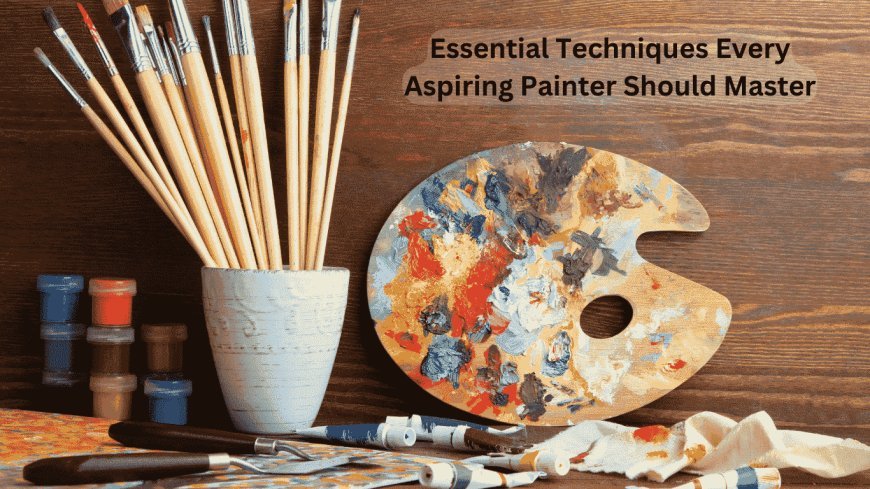10 Essential Techniques Every Aspiring Painter Should Master
Discover the top 10 painting techniques every aspiring artist needs to know. From brushwork to color theory, learn how to refine your skills and unleash your creativity.

Introduction
Painting is a thrilling creative and self-expression adventure. Painting requires understanding important methods, whether you're a novice or an experienced enthusiast. It's not simply talent—practice and knowledge matter. Understanding core abilities lets you realize your artistic idea in new ways.
This article covers 10 basic painting methods any aspiring painter should know. These abilities will enhance your confidence and help you succeed artistically. Jump in!
1. Mastering Brushwork
The brush is an extension of your hand. To use it effectively:
Hold it correctly: Try holding the brush closer to the bristles for precision or farther back for looser strokes.
Control pressure: Light pressure makes thin strokes, hard ones bold.
Strokes: Practice large sweeping lines and little dabs to acquire confidence.
Tips: Use high-quality brushes and clean them after each use to prolong their life..
2. Understanding Color Theory
Every great painting starts with color theory. Focus on these:
All colors come from red, blue, and yellow.
Try mixing primaries to make secondary and tertiary hues.
Cool and warm tones: Blue and green quiet, while red and yellow energize.
Knowing how to harmonize colors makes flat work vibrant.
3. Blending for Smooth Transitions
Soft gradients and realistic effects need blending. The art of blending:
Smooth color transitions with a dry, clean brush.
Avoid sharp lines by working swiftly while the paint is wet.
Try wet-on-wet (oils and acrylics) or layering (watercolors).
Blending gives paintings a professional finish.
4. Layering for Depth
Create depth and dimension using layers. To prevent muddy colors, start with softer tones and add deeper ones gradually. Layering is easy with acrylics and oils, which dry rapidly.
BONUS TIP: Let a layer dry before applying another!
5. The Art of Composition
A powerful composition starts an excellent painting. Follow these guidelines.
Divide your canvas into horizontal and vertical thirds and add focus points along them.
Avoid overpopulation by balancing elements.
Leading lines: Draw attention to essential elements of your picture.
Composition enhances storytelling and audience engagement.
6. Dry Brush Technique
Dry brushing is ideal for texture and detail. Dip an almost dry brush with paint and softly touch the canvas. This approach is good for:
Showcasing information.
Rough textures like grass or wood grain.
Change brush shapes to create distinct effects.
7. Exploring Impasto
Thick paint layers produce a three-dimensional impression in impasto. To attempt impasto:
Use a palette knife or stiff brush for thick paint.
Add drama to your painting with powerful strokes.
The ideal paints for this method are oil or acrylic.
8. Wet-on-Wet Technique
To mix and create delicate effects, use wet-on-wet. It suits watercolors and oils. To utilize this method:
Apply wet paint to moist surfaces.
For dreamy, ambient effects, let colors blend organically.
This style is used for sky and water in landscapes.
9. Detailing with Precision
Painting details may make or ruin it. For better detailing:
Make complex strokes using fine-tip brushes.
Take your time and work steadily.
Save details till the end of painting to avoid smudging.
Highlights and shadows enhance details!
10. Practicing Patience and Persistence
Practice and perseverance are essential to improving, regardless of how many skills you master. Schedule painting time and don't worry if it's not perfect. Every brushstroke, error, every painting is progress.
Tips for Aspiring Painters
Do not be hesitant to attempt new methods or styles.
Check out excellent artists: Examine your favorite painters' methods.
Maintain your items: Maintaining brushes, paints, and canvas makes a tremendous impact.
FAQs About Painting Techniques
Q: What paint should a novice use?
Beginning with acrylic paints is ideal. Versatile, quick-drying, and beginner-friendly.
How do I pick a brush?
Try different brushes (flat, round, filbert) to determine which work best for different methods.
Can I blend painting styles?
Absolutely! Using impasto and wet-on-wet may generate fascinating results.
Q: How do I mix without muddy colors?
Use clean brushes and combine less colors. Build layers slowly.
Wrapping It Up
Learn these 10 basic painting methods to start your artistic journey. Enjoy your brushwork, color theory, and depth layering experiments and keep practicing. Remember, all great painters started off!
Grab your brushes, unleash your imagination, and start your artistic adventure. Your canvas—make it great!
Favorite painting technique? Leave a remark and share this information with other aspiring artists!

 shofiul
shofiul 





